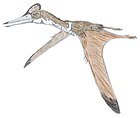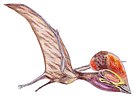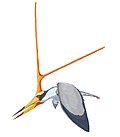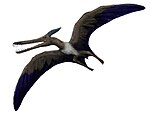Novialoidea
| Novialoidea | |
|---|---|

| |
| Fossil specimen of Campylognathoides liasicus, a basal novialoid. | |
| Scientific classification | |
| Domain: | Eukaryota |
| Kingdom: | Animalia |
| Phylum: | Chordata |
| Order: | †Pterosauria |
| Clade: | †Macronychoptera |
| Clade: | †Novialoidea Kellner, 2003 |
| Subgroups | |
| |
| Synonyms | |
| |
Novialoidea (meaning "new wings") is an extinct clade of macronychopteran pterosaurs that lived from the latest Early Jurassic to the latest Late Cretaceous (early Toarcian to late Maastrichtian age[3]), their fossils having been found on all continents except Antarctica.[4]
History and classification
[edit]Novialoidea was named by paleontologist Alexander Wilhelm Armin Kellner in 2003 as a node-based taxon consisting of the last common ancestor of Campylognathoides, Quetzalcoatlus and all its descendants. This name was derived from Latin novus "new", and ala, "wing", in reference to the wing synapomorphies that the members of the clade possess.[5]
Paleontologist David Unwin in 2003 had named the group Lonchognatha in the same issue of the journal that published Novialoidea (Geological Society of London, Special Publications 217) and defined it as Eudimorphodon ranzii, Rhamphorhynchus muensteri, their most recent common ancestor and all its descendants (as a node-based taxon).[6] Under Unwin's and Kellner's phylogenetic analyses (where Eudimorphodon and Campylognathoides form a family that is basal to both Rhamphorhynchus and Quetzalcoatlus), and because Novialoidea was named first (in pages 105–137, while Lonchognatha was named in pages 139–190), Lonchognatha is an objective junior synonym of the former. However, other analyses find Lonchognatha to be valid (Andres et al., 2010),[7] or synonymous with the Pterosauria (Andres, 2010).[8]
Below is a cladogram showing the phylogenetic analysis conducted by Brian Andres and colleagues in 2014. Based on the analysis, Novialoidea contains the genus Campylognathoides as well as the group Breviquartossa.[9]
| Novialoidea | |
References
[edit]- ^ Vidovic, Steven U.; Martill, David M. (2017). "The taxonomy and phylogeny of Diopecephalus kochi (Wagner, 1837) and Germanodactylus rhamphastinus (Wagner, 1851)" (PDF). Geological Society, London, Special Publications. 455: 125–147. doi:10.1144/SP455.12. S2CID 219204038.
- ^ Codorniú, Laura; Paulina Carabajal, Ariana; Pol, Diego; Unwin, David; Rauhut, Oliver W.M. (2016). "A Jurassic pterosaur from Patagonia and the origin of the pterodactyloid neurocranium". PeerJ. 4: e2311. doi:10.7717/peerj.2311. PMC 5012331. PMID 27635315.
- ^ Barrett, P. M., Butler, R. J., Edwards, N. P., & Milner, A. R. (2008). Pterosaur distribution in time and space: an atlas. Zitteliana, 61-107. [1]
- ^ Richard J. Butler; Stephen L. Brusatte; Brian B. Andres; Roger B. J. Benson (2012). "How do geological sampling biases affect studies of morphological evolution in deep time? A case study of the Pterosauria (Reptilia: Archosauria)". Evolution. 66 (1): 147–162. doi:10.1111/j.1558-5646.2011.01415.x. PMID 22220871. S2CID 205783384.
- ^ Kellner, A. W. A., (2003): Pterosaur phylogeny and comments on the evolutionary history of the group. pp. 105-137. — in Buffetaut, E. & Mazin, J.-M., (eds.): Evolution and Palaeobiology of Pterosaurs. Geological Society of London, Special Publications 217, London, 1-347
- ^ Unwin, D. M., (2003): On the phylogeny and evolutionary history of pterosaurs. pp. 139-190. — in Buffetaut, E. & Mazin, J.-M., (eds.): Evolution and Palaeobiology of Pterosaurs. Geological Society of London, Special Publications 217, London, 1-347
- ^ Brian Andres, James M. Clark & Xu Xing (2010) A new rhamphorhynchid pterosaur from the Upper Jurassic of Xinjiang, China, and the phylogenetic relationships of basal pterosaurs, Journal of Vertebrate Paleontology, 30:1, 163-187, DOI: 10.1080/02724630903409220
- ^ Andres, Brian Blake (2010). Systematics of the Pterosauria. Yale University. p. 366. A preview that shows the cladogram without clade names
- ^ Andres, B.; Clark, J.; Xu, X. (2014). "The Earliest Pterodactyloid and the Origin of the Group". Current Biology. 24 (9): 1011–6. doi:10.1016/j.cub.2014.03.030. PMID 24768054.












